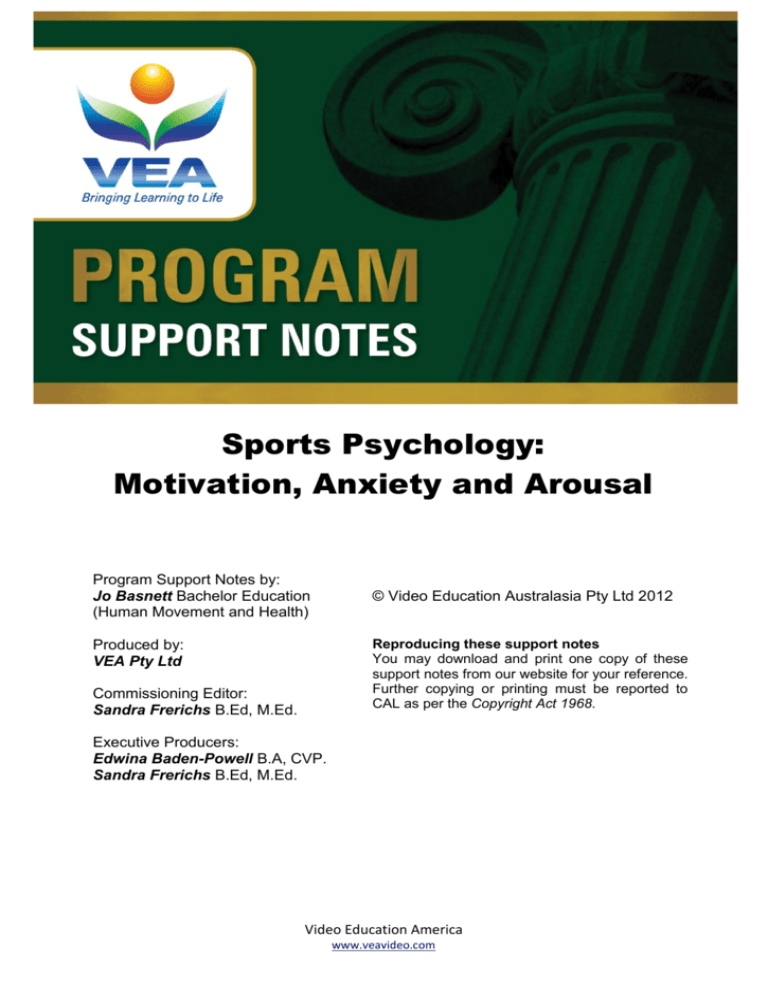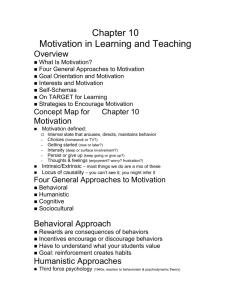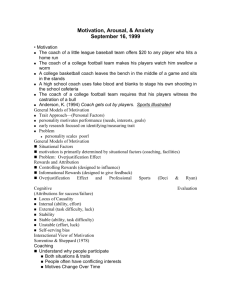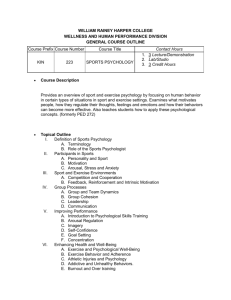Sports Psychology: Motivation, Anxiety and Arousal
advertisement

Sports Psychology: Motivation, Anxiety and Arousal Program Support Notes by: Jo Basnett Bachelor Education (Human Movement and Health) © Video Education Australasia Pty Ltd 2012 Reproducing these support notes You may download and print one copy of these support notes from our website for your reference. Further copying or printing must be reported to CAL as per the Copyright Act 1968. Produced by: VEA Pty Ltd Commissioning Editor: Sandra Frerichs B.Ed, M.Ed. Executive Producers: Edwina Baden-Powell B.A, CVP. Sandra Frerichs B.Ed, M.Ed. Video Education America www.veavideo.com Sports Psychology: Motivation, Anxiety and Arousal For Teachers Introduction It is commonly accepted that mental preparation for athletic pursuits is essential for optimal performance, and that athletes generally perform better with knowledge and application of psychological principles and strategies. Research continues to suggest that there is significant potential to improve performance through mental training. Reasons why people perform differently in sporting activities relate mainly to physical factors, including genetic makeup, fitness level and skill. However, better understanding of specific psychological influences, notably motivation, arousal and anxiety management is becoming increasingly important as these influences can significantly enhance or inhibit performance depending on the way they are managed. Timeline 00:00:00 00:05:35 00:10:23 00:15:47 00:20:41 00:21:33 Motivation Anxiety Managing stress Arousal Credits End program Related Titles Sports Psychology: Mental Preparation Performance Enhancing Substances in Sport Nutrition and Hydration in Sports Recommended Resources http://content.jacplus.com.au/secure/resources/1742160816/PDF/Chapter/5_61_60816_O2_HSC_ 4E_06.pdf http://www.brianmac.co.uk/companx.htm http://www.brianmac.co.uk/mental.htm http://www.mindbiz.com.au/visualisation.htm http://sportsmedicine.about.com/od/sportspsychology/tp/Common-Sports-PsychologyMistakes.htm http://www.csmonitor.com/World/Olympics/2010/0222/For-many-Vancouver-Olympics-athletessports-psychology-is-key Outcomes 2 HSC Textbook Application and Inquiry HSC Textbook PDHPE In Focus HSC Textbook 2 © Video Education Australasia Pty Ltd 2012 Reproducing these support notes You may download and print one copy of these support notes from our website for your reference. Further copying or printing must be reported to CAL as per the Copyright Act 1968. Sports Psychology: Motivation, Anxiety and Arousal Student Worksheet Initiate Prior Learning 1. Brainstorm examples of positive, negative, intrinsic and extrinsic motivators in sport. 2. Choose a sport or activity in which you regularly participate. Explain the motivational forces that have driven you when you have achieved your best. _________________________________________________________________________________ _________________________________________________________________________________ _________________________________________________________________________________ _________________________________________________________________________________ _________________________________________________________________________________ 3. Are the motivators you chose the same as all your class mates? Why/why not? _________________________________________________________________________________ _________________________________________________________________________________ _________________________________________________________________________________ 4. Think of times when you have been anxious and nervous when facing a challenge. What strategies did you employ to overcome these nerves? Do you think athletes utilize similar strategies? Why/why not? _________________________________________________________________________________ _________________________________________________________________________________ _________________________________________________________________________________ _________________________________________________________________________________ _________________________________________________________________________________ 5. Use your own words to define ‘choking’ in sport. Justify why you believe this can happen at all levels in sport. _________________________________________________________________________________ _________________________________________________________________________________ _________________________________________________________________________________ _________________________________________________________________________________ 3 © Video Education Australasia Pty Ltd 2012 Reproducing these support notes You may download and print one copy of these support notes from our website for your reference. Further copying or printing must be reported to CAL as per the Copyright Act 1968. Sports Psychology: Motivation, Anxiety and Arousal Active Viewing Guide Motivation 1. Complete the following sentence. ‘How well an athlete performs is driven by……’ _________________________________________________________________________________ 2. Give three examples that the athletes in this program say keeps them motivated. _________________________________________________________________________________ _________________________________________________________________________________ _________________________________________________________________________________ 3. Explain the difference between ‘intrinsic’ and ‘extrinsic’ motivation. Provide examples for each. _________________________________________________________________________________ _________________________________________________________________________________ _________________________________________________________________________________ _________________________________________________________________________________ 4. Why do you think different athletes have different motivations? _________________________________________________________________________________ _________________________________________________________________________________ _________________________________________________________________________________ Anxiety and Fear 5. How can Kelly use her fear and anxiety positively? _________________________________________________________________________________ _________________________________________________________________________________ 6. Name the two ways an athlete responds to stressful situations. Give an example of each. _________________________________________________________________________________ _________________________________________________________________________________ _________________________________________________________________________________ _________________________________________________________________________________ 4 © Video Education Australasia Pty Ltd 2012 Reproducing these support notes You may download and print one copy of these support notes from our website for your reference. Further copying or printing must be reported to CAL as per the Copyright Act 1968. Sports Psychology: Motivation, Anxiety and Arousal 7. Compare state and trait anxiety. _________________________________________________________________________________ _________________________________________________________________________________ _________________________________________________________________________________ 8. Most athletes experience nerves at some point in their career. What is important for them to learn from the experience? _________________________________________________________________________________ _________________________________________________________________________________ _________________________________________________________________________________ Managing Stress 9. Why would some people like competition pressure? _________________________________________________________________________________ _________________________________________________________________________________ _________________________________________________________________________________ 10. Define the various types of pressure. _________________________________________________________________________________ _________________________________________________________________________________ _________________________________________________________________________________ _________________________________________________________________________________ 11. What is one way an athlete can deal with pressure? _________________________________________________________________________________ _________________________________________________________________________________ Arousal 12. Explain Under Arousal. _________________________________________________________________________________ _________________________________________________________________________________ _________________________________________________________________________________ 5 © Video Education Australasia Pty Ltd 2012 Reproducing these support notes You may download and print one copy of these support notes from our website for your reference. Further copying or printing must be reported to CAL as per the Copyright Act 1968. Sports Psychology: Motivation, Anxiety and Arousal 13. Explain Over Arousal. _________________________________________________________________________________ _________________________________________________________________________________ _________________________________________________________________________________ 14. Explain Optimal Arousal. _________________________________________________________________________________ _________________________________________________________________________________ _________________________________________________________________________________ 15. Discuss why golf and rugby union would require varying degrees of optimal arousal, with reference to the Inverted U Hypothesis? _________________________________________________________________________________ _________________________________________________________________________________ _________________________________________________________________________________ _________________________________________________________________________________ _________________________________________________________________________________ _________________________________________________________________________________ 6 © Video Education Australasia Pty Ltd 2012 Reproducing these support notes You may download and print one copy of these support notes from our website for your reference. Further copying or printing must be reported to CAL as per the Copyright Act 1968. Sports Psychology: Motivation, Anxiety and Arousal Extension Activities 1. Imagine you are the coach of an up and coming young sportsperson (in the sport of your choice). a) Prepare a speech aimed at this sportsperson, outlining the benefits of speaking regularly to a sport psychologist. Make sure your speech is specific to the sport, for example if you choose to be ‘coach’ of a footballer your points may be different from the ‘coach’ of a diver. Include an (invented) example from the sportsperson’s past where they choked and explain to them how they might have dealt with the situation differently if they’d had the benefit of advice from a sports psychologist. Make sure your arguments are convincing. b) Present your speech to the class. As a class, evaluate the successfulness of the speech in persuading the sportsperson to start seeing a sport psychologist. What were the most convincing points made by the ‘coach’? Be prepared to discuss the reasons behind why you focused on particular points within your speech. 2. In pairs, create a role play of a session with a sports psychologist and a sportsperson. Start with a scenario where the sportsperson has recently experienced ‘choking’ and is coming to the psychologist to discuss the experience. 3. Research the profession of sport psychologist. What sort of education and training do they go through to get into the industry? What types of sports or athletes are they most likely to be associated with? 4. Use the Internet to find a recent study on the area of sport psychology or mental preparation for athletes. (Google Scholar is one place to start looking. Use the words from the title of this program or keywords used within the program as your search terms.) Write a one page report summarizing this research. Include the following in your report: where the research was conducted and by whom, which area(s) of sport it focused on, the main conclusions reached, anything interesting/surprising that you learnt from the research, anything that you didn’t understand or found confusing about the study. Discuss your report with a classmate. 5. Use the following topic for a class debate: ‘Once an athlete experiences ‘choking’, they will not reach optimal performance again’. 7 © Video Education Australasia Pty Ltd 2012 Reproducing these support notes You may download and print one copy of these support notes from our website for your reference. Further copying or printing must be reported to CAL as per the Copyright Act 1968. Sports Psychology: Motivation, Anxiety and Arousal Suggested Student Responses Initiate Prior Learning 1. Brainstorm examples of positive, negative, intrinsic and extrinsic motivators in sport. Answers will vary but may include sponsorship, financial motivators, glory, represent country, Olympics, desire, coach’s feedback (positive and negative) 2. Choose a sport or activity in which you regularly participate. Explain the motivational forces that have driven you when you have achieved your best. Answers will vary 3. Are the motivators you chose the same as all your class mates? Why/why not? Answers will vary but will generally be ‘no’ as each individual responds differently to various motivation 4. Think of times when you have been anxious and nervous when facing a challenge. What strategies did you employ to overcome these nerves? Do you think athletes utilize similar strategies? Why/why not? Answers will vary 5. Use your own words to define ‘choking’ in sport. Justify why you believe this can happen at all levels in sport. Answers will vary 8 © Video Education Australasia Pty Ltd 2012 Reproducing these support notes You may download and print one copy of these support notes from our website for your reference. Further copying or printing must be reported to CAL as per the Copyright Act 1968. Sports Psychology: Motivation, Anxiety and Arousal Active Viewing Guide Motivation 1. Complete the following sentence. ‘How well an athlete performs is driven by……’ What motivates them. 2. Give three examples that the athletes in this program say keeps them motivated. Answers will vary but may include: self motivation, drive, intrinsic factors i.e. feeling of the execution in their sport, winning, Olympic gold medal, recognition, competing for your country, tangible things, teammates, what they can bring to their game, watching their own sport, coaches, 3. Explain the difference between ‘intrinsic’ and ‘extrinsic’ motivation. Provide examples for each. Intrinsic = motivation from within eg drive to win, to compete at Olympics etc, extrinsic comes from external sources i.e. Coaches, parents, sponsors. Intrinsic usually occurs at the beginning of their career 4. Why do you think different athletes have different motivations? Answers will vary but may include personality type, type of sport played and level of competition Anxiety and Fear 5. How can Kelly use her fear and anxiety positively? Channel it into her performance – to achieve optimal outcomes 6. Name the two ways an athlete responds to stressful situations. Give an example of each. Somatically/bodily – muscle tension and cognitively – mentally, may be unable to focus 7. Compare state and trait anxiety. State anxiety is a heightened sense of worry for specific scenarios eg choking – fails to perform. Trait anxiety is anxiety generally throughout all their life from inherited factors, i.e. a more nervous person everyday 8. Most athletes experience nerves at some point in their career. What is important for them to learn from the experience? Answers will vary but may include need to learn how to control the nerves and at what levels they can be useful to them during performance, also that a positive feeling can follow from having succeeded in their activity Managing Stress 9. Why would some people like competition pressure? Boost adrenaline, all the work leading up to the one moment, excited to perform etc 10. Define the various types of pressure. Physical pressure – to be physically fit at the optimal time, social pressure– media expectation and family/coach pressure, social mediums and personal pressure – may set unrealistic goals 11. What is one way an athlete can deal with pressure? Answers will vary but may include: setting realistic goals, focus on what they want to achieve not what they want to avoid, put a ‘yet’ on the end, focus on the next bit of play, train regularly 9 © Video Education Australasia Pty Ltd 2012 Reproducing these support notes You may download and print one copy of these support notes from our website for your reference. Further copying or printing must be reported to CAL as per the Copyright Act 1968. Sports Psychology: Motivation, Anxiety and Arousal Arousal 12. Explain Under Arousal. Easier to manage, not pumped up enough 13. Explain Over Arousal. Choking, muscles seize up, mind races and no longer perform tasks that they usually do with ease, over expectation and pressure 14. Explain Optimal Arousal. Shown through the Inverted U Hypothesis – need a certain amount of arousal to ensure optimal performance. This level of arousal will depend on the athlete and sport. Staying ‘in the zone’ and performing at their best 15. Discuss why golf and rugby union would require varying degrees of optimal arousal, with reference to the Inverted U Hypothesis? Golf requires steady hand and body, therefore less adrenalin and ‘psyching up’ required whereas Rugby would require the level of adrenalin to increase to perform at a higher intensity 10 © Video Education Australasia Pty Ltd 2012 Reproducing these support notes You may download and print one copy of these support notes from our website for your reference. Further copying or printing must be reported to CAL as per the Copyright Act 1968.





